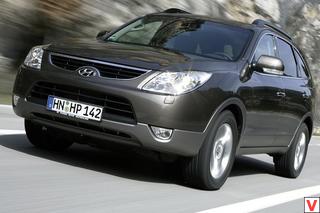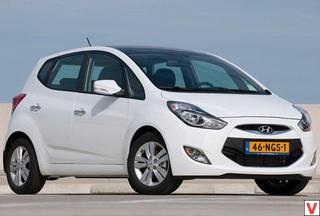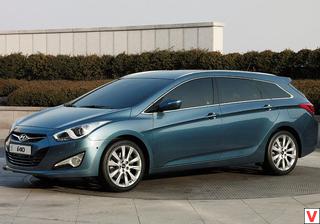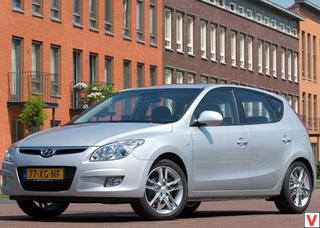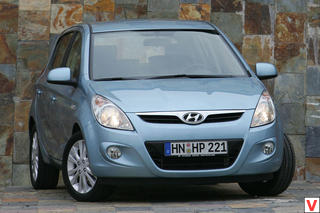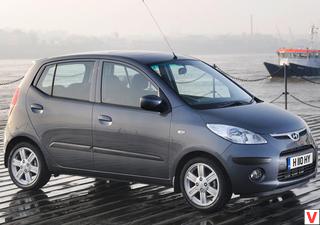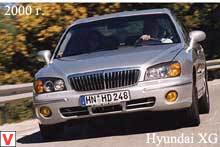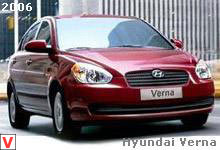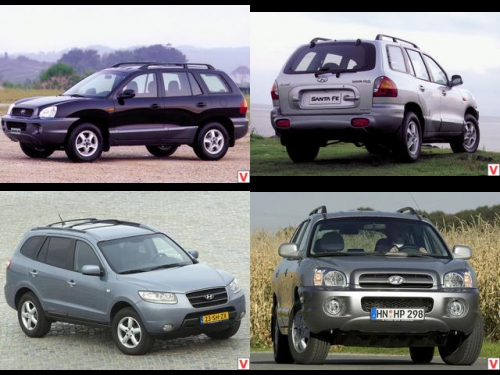
For the first time, the general public met the Hyundai Santa Fe in 1999 at the Detroit Auto Show. A year later, the company released the first production car. Prior to this, Hyundai did not have in its arsenal of self-developed jeeps, since Galloper is a copy of an earlier version of the Mitsubishi Pajero. Santa Fe is a parquet SUV, independently developed by Hyundai. It is distinguished by the impressive dimensions of 4505x1820x1675 mm and a high level of equipment in terms of safety and comfort. Muscular fenders, a bumpy hood, a huge bumper, two rows of air intakes and fog lamps create a very aggressive look.
Initially, the line of power units was represented by two petrol engines in a transverse position: a 2-liter inline "four" with a capacity of 136 hp. and a 179-horsepower V6 of 2.7 liters. The first engine was paired exclusively with a manual transmission and installed on front-wheel drive models.
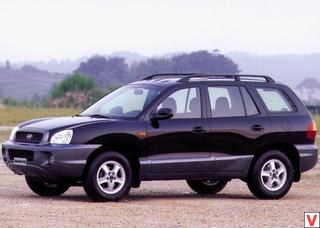
A more powerful engine was put on all-wheel drive modifications paired with automatic transmission. Then the gamma of power units was supplemented by a 2.4-liter gasoline 4-cylinder engine with a volume of 2.4 liters and 150 liters capacity. The cabin is quite spacious, which is especially important; passengers in the back rows will obviously not feel the lack of space. If you lower the backrest of all seats, you get a great wide surface. The dashboard includes: tachometer, temperature and fuel sensors, electronic clock and odometer.
The luggage compartment is roomy in size with a special net for load stopping. From prying eyes, the contents of the trunk can be closed with a curtain. The fifth door is arranged according to the American principle. For loading and unloading of small things, you can use the window, and if there is a need to transport bulky goods, open the door entirely. The security system consists of: energy absorbing materials used in the construction of bumpers, steel beams in doors and airbags. On Santa Fe, there are four pillows (two - in front, one on each side).
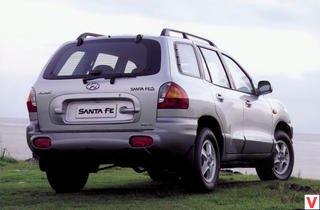
The one to the right of the driver is equipped with a special detector, which is turned on if the passenger is present, and is turned off if it is not there. Santa Fe has a monocoque body, a fully independent suspension (MacPherson front, multi-link rear) and all-wheel drive transmission without a down row. Four-wheel drive on Santa Fe, which is not very typical for this class, is constantly on, and the torque is divided between the front and rear axles in the ratio of 40:60, which should ensure the most efficient implementation of engine traction capabilities and good handling. In 2001 comes the version with a 2-liter 113-horsepower diesel with a turbocharger.
With this engine, the updated Santa Fe accelerates to 100 km / h in 13.3 seconds and reaches a maximum speed of 172 km / h. In a couple of it offers a 4-speed "automatic" or manual transmission. In the same year, Santa Fe topped the safety rating compiled by the US Insurance and Road Safety Institute.

Leaving behind Jeep Wrangler and Cherokee, Toyota RAV 4, Honda CRV and Ford Escape. Specialists highly appreciated the structural reinforcement of the body, head restraints and other elements of passive safety, noted a low probability of injury to the chest and legs. The gearbox is automatic, with manual shift, front-wheel drive, rear axle is connected, if necessary, via a viscous coupling, independent suspensions. The front brake disc, rear - drum. The car's design was developed by Hyundai specialists from the California branch. The name of the car also has American roots.
Santa Fe is the name of a city in the state of New Mexico. The successfully chosen style and technical concept of Santa Fe is evidenced by the fact that it was restyled only four years after the model was released. His main goal was to slightly change the appearance of the car, which has already become familiar. Exterior and interior got a lot of new and improved parts. The color scheme is replenished with new colors. The front of the car is crowned with an updated grille with a transverse line. The back of the received new lighting, bumper and door.

Changed the shape of the side and rear protective plates, as well as the design of 16-inch alloy wheels. The image was more dynamic and aggressive. It was decided to make the interior two-color. A little finalized dashboard. Do not forget about the safety of passengers.
In the updated version, all the second-row seats were equipped with three-point belts and began to install airbags of improved design. Added a number of additional options. Now, if you wish, you can equip your car with an on-board computer, climate control, a speed control system and heated bottom of the windscreen.

These options are basic for all versions equipped with all-wheel drive. By 2006, the Santa Fe SUV was completely modified. The design and many elements of the design of the new SUV were designed from scratch. Hyundai spent more than two years and $ 150 million to upgrade its car. The model has become larger, more powerful and more comfortable than the previous one.
The stylish and dynamic appearance with smooth lines of the case, verified to the smallest detail, in no way resembles the previous model. Large and heavy, but at the same time quite elegant body looks respectable. Massive embossed side, large grille, predatory narrowed headlights. The design is clearly a success, for its development should thank the bureau Hyundai, located in California. The new Santa Fe has become taller, wider and longer than its predecessor, which allows the manufacturer to complete it with a third row of seats. If a third row of seats is installed, seven passengers can be accommodated in the cabin.

The third row is suitable for children rather than adults, but on the whole the internal space of the car is worthy for this class. Chairs of the third row are folded against 5/5, the second - 6/4. The total cargo volume is 2.21 meters. The salon has a three-color range and boasts wooden details. The dashboard is facing the driver, all the sensors are in place, the readability of the devices is at a high level. The illumination of all the instruments, buttons, twirls and spitters is blue, which adds charm to the interior.
Hyundai Santa Fe is equipped with three versions of the engines - a 2.2 liter turbodiesel (150 hp), a 3.3 liter petrol engine V6 (235 hp) and a 2.7 liter petrol V6 (189 hp) . Gearbox - the choice of either a 5-speed manual or automatic with four steps. The 2.7 engine is completely aluminum, equipped with CVVT (Constantly Variable Valve Technology) and VIS (Variable Intake System) systems, thanks to which it provides high torque over a wide rpm range, and has improved fuel consumption characteristics.
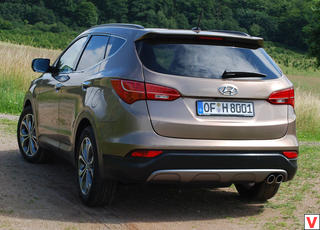
McPherson type front suspension and rear multi-link, provide clear controllability, increase the smoothness of the course on a straight road and increase the stability of the car's cornering. Santa Fe is available in three versions. The base Santa Fe GLS is equipped with 16-inch wheels, heated electric windows and electric mirrors, cruise control and a CD player.
The SE model is equipped with a larger engine, 18-inch alloy wheels, automatic headlights, an on-board computer and a stereo control panel built into the steering column. The Limited package includes SE elements, plus leather seats (front heated), electric driver's seat adjustment and dual automatic climate control. On all Santa Fe you can install XM satellite radio. Options are offered as packages.
On Santa Fe, you can install a third row of seats and a panoramic sunroof, as well as a DVD system (only for SE and Limited). An advanced stereo system with a six-disc CD changer is offered for the SE. All three models of Santa Fe are equipped with front or full (AWD) drive. All security elements of Santa Fe are standard.
The list includes all disc brakes, traction control, stability control, side airbags, active front head restraints and a tire pressure sensor. Innovative technologies, modern design solutions, competitive price, standard safety elements allowed Santa Fe to become one of the best cars in its class. Hyundai presented at the Detroit Motor Show in 2010 an updated European version of the Santa Fe SUV.
The main changes affected the power units, but not without light external and internal modifications, including a new grille, revised bumpers, modified fog lights in black framed, updated taillights, lighter trapezoid exhaust pipes, new standard alloy wheels, converted thresholds and rails on the roof. The interior has been updated, a built-in navigation system has appeared, optionally a rear-view camera can be installed. All Santa Fe cars now include a standard Bluetooth wireless headset, audio controls on the steering wheel, a new dark wood trim, and a metal decorative steering wheel. The devices received a new font and design of the backlight.
Also available is a new touch screen navigation system with a rear backup camera. There are two options for picking Santa Fe 2010 - the “Style” and “Premium” kits. Style models come with 17-inch alloy wheels, motion sensors, air conditioning and ESP. In the "Premium" wheels are already 18-inch, dual climate control with rear seat control in the seven-seater version, leather seats with gouting and auto-tuning for the driver, automated lights and wipers. Well, now, about the most important changes that are hidden under the hood. A new 4-cylinder turbo diesel engine with a 2.2-liter capacity has been added, which produces 197 hp of power.
and a torque of 422 Nm at a crankshaft speed between 1,800 and 2,500 rpm. This engine accelerates Hyundai Santa Fe from zero to 100 km / h in 9.8 seconds, the maximum speed of 190 km / h. Fuel consumption in the combined cycle is 6.6 l / 100km, CO2 emissions are 174 g / km. In addition to the diesel engine, the new 2.4-liter Theta-II gasoline four-cylinder engine with a volume of 2.4 liters is also available.
It produces 174 hp. and 228 Nm of torque. It accelerates the car from zero to 100 km / h in 10.7 seconds and a maximum speed of 190 km / h. Mixed fuel consumption of 8.5 l / 100km, CO2 emissions of 203 g / km. I received Santa Fe of 2010 and a new “six” - it became the Lambda II engine with a volume of 3.5 liters, issuing 376 hp.
and 335 Nm of torque. New Hyundai Santa Fe engines are offered with a six-speed manual transmission. Optionally, as an option, can be combined with a new six-speed automatic transmission. In addition, in versions with automatic transmission appeared fuel economy indicator. Previously offered four and five-speed transmission options.
Features all-wheel drive Hyundai Santa Fe 2010. When driving on a flat dry road at a constant speed, all torque is transmitted to the front wheels. When one of them slips, part of the thrust (up to 50%) begins to be transmitted to the rear axle. An electronically controlled multi-plate friction clutch is responsible for this process. The driver has the ability to forcibly change the distribution of thrust in the transmission: on the center panel to the left of the steering column there is a button for locking the clutch - 4WD Lock.
Another way to improve the properties of the car on the roads is the ability to turn off the system of dynamic stability control: the ESP off key is located next to the 4WD Lock button. The lifting capacity of the car has been increased by 300 kilograms and is now 2500 kg. In addition to all this, Santa Fe has a five-year warranty. At the 2012 New York Auto Show, the debut of the third-generation facelift version of Santa Fe was made. The car was presented in two versions - a five-seater Sport and a seven-seater with an increased wheelbase. The Russian presentation of the novelty took place at the Moscow Motor Show 2012. The updated Santa Fe has become more solid and brutal.
The design of the model is made in the current corporate style Fluidic Sculpture with a hexagonal grille, narrow lighting technology and numerous sub-stamping. Facelift touched the front and rear bumpers, fog lights, roof rails, as well as drawing wheel rims. The stylish design of the sidelines, not only filled with dynamism, but also, according to the designers, led to a decrease in drag coefficient to 0.34. In the US market, the base five-seater Hyundai Santa Fe 2013 is sold with the Sport prefix. Its overall length is 4,690 mm, width - 1,880, height - 1,680, and the size of the wheelbase - 2,700 mm.
The seven-seater version of the crossover turned out to be 215 mm longer, 5 mm wider, 10 mm higher, and the wheelbase is stretched to 2,800 mm, which is 10 cm more than the Sport version. But the interior design in both versions is the same - with a new front panel and improved trim materials. The salon is designed in the spirit of the latest Hyundai models. Optitronnaya dashboard with a pleasant blue backlight is equipped with a color 4.3-inch display to display supporting information. In the middle of the center console is an 8-inch LCD-display, which displays all the necessary information, as well as data from the navigation system.
By the way, the latter can be ordered with one of two software options: Navitel or Navteq. According to representatives of Hyundai, this choice is due to local customer preferences. The updated Santa Fe is available in five trim levels: Comfort, Dynamic, Sport, High-Tech and Family. Standard Comfort equipment includes 6 airbags, ESP stability control, LED running lights, rain sensor, R17 alloy wheels, heated front seats, electric heated mirrors, trip computer, electric power steering, ABS, HAS, DBC, ESC. In this configuration, Hyunda Santa Fe has two versions - front-wheel drive and all-wheel drive.
In the Sport package, the car is equipped with 18-inch alloy wheels, a driver's knee airbag, keyless entry to the cabin, an electric driver's seat and the Navteq navigation system with an 8-inch monitor. The High-Tech version comes with 19-inch alloy wheels, a panoramic roof, driver seat and mirror settings, adaptive xenon headlights, an automatic parking system, navigation with Navitel cartography, and much more. A seven-seater version of the car - with all-wheel drive and an automatic transmission - is available in the Family version.
There are roof rails, leather trim, xenon headlights, rear parking sensors, a Supervision dashboard with a color TFT display, and a multimedia system with a 4.3-inch display and a rear-view camera. Santa Fe is delivered to us in five- and seven-seater versions with two motors to choose from. The first 2.4-liter gasoline engine develops 175 liters. from.
and a maximum torque of 227 Nm. To accelerate to 100 km / h, it takes 11.6 seconds with an automatic transmission and one-tenth less from a manual transmission. The second turbocharged diesel volume of 2.2 liters capacity of 197 liters. from. and a solid maximum torque of 436 Nm.
With this engine, acceleration to the “hundred” in the front-wheel drive version takes 9.8 seconds, and the all-wheel drive model is controlled in 10.1 seconds.
